This post may contain affiliate links. This just means I may receive a small commission at no extra cost to you for helping them promote their product or service. I don’t endorse any services I don’t personally use or recommend.
Let me take you on an adventure filled with shrimp tacos, long winding roads, and cobblestoned town squares. It’s a Baja Peninsula road trip. Arguably, the most scenic (& easy) road trip in Mexico.
It’s safe, it’s beachy, it’s teeming with cacti straight from the imagination of Dr. Suess. The nearly 1,000 mile-long peninsula offers pristine tropical beaches, wine country that rivals the nearby California Napa Valley, and life-saving lush palm-fringed oasis. You’ll savor desert sunsets sitting near a pack of coyotes surrounded by Saguaro cacti as the landscape is bathed in pastel pink. But for most out-of-country road trippers, it’s those undeveloped white sand beaches that draw you in.
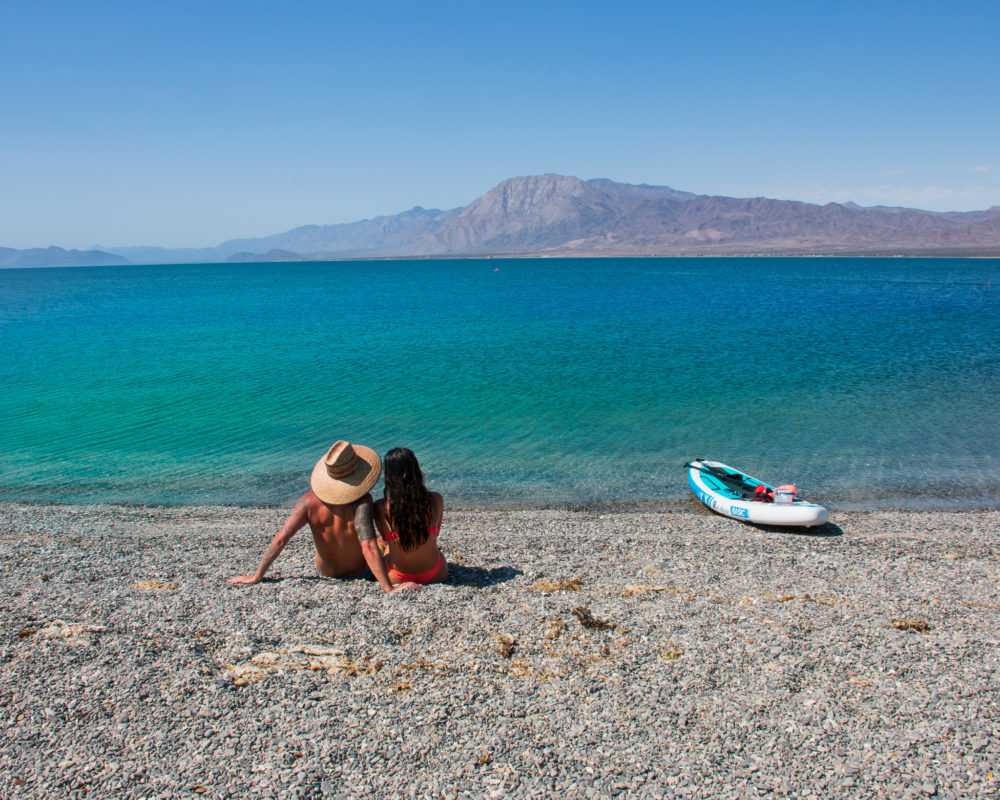
I can’t rave about the beaches enough. I’ve enjoyed vanlife along the West Coast Highway 101, Florida, and spent months playing on the shores of Sri Lanka, Indonesia, & Thailand’s beaches. And honestly, the Baja beaches are incredible. Rivaling the sands of SEAsia. You’ve likely heard of the turquoise water and limestone arches of Cabo San Lucas (the trashy resort town on the southern tip of the peninsula), but Baja has far better stretches of sand. We’ll dive into those a little later.
Planning an international road trip can be overwhelming. You’ve got border crossings, a fresh set of traffic laws, language barriers, and an unfamiliar food scene. Even something as simple as getting gas can be infinitely more complicated. But don’t you fret. We spent a month on the Baja Peninsula gathering all the info you need to grab your keys and hit the road on an epic Baja Peninsula road trip.
Getting Ready for a Baja Peninsula Road Trip
Let’s talk trip planning. The things you need to know before you go. But first…
Is Baja Mexico Safe?
Yup.
You won’t have any cartel run-ins or shake-downs. I slept most nights with all my doors wide open on the beach without any hassle. I wouldn’t dare try that in the United States.
Nowhere in the world is without risk. But it’s very likely the most dangerous activity you’ll encounter is driving.
The Baja Peninsula is divided into two separate states. Baja Norte, also known as Baja California, & Baja California Sur. Both are heavily touristed. & the prices often reflect that. I wouldn’t go as far as to call the region “westernized” but it’s different from the rest of Mexico. Newer, beachier, and with a more laid-back vibe. Surrounded by fellow road trippers, safety won’t be a concern on a Baja peninsula road trip.
Best Time to Visit Baja
Spoiler: It’s not Summer.
Baja summers are sweltering. The air is sticky and humid with daytime temps reaching 110 degrees (F) and nighttime lows barely creeping down to 90 degrees (F) in some regions.
We did our big Baja Peninsula road trip in June. It was mind-meltingly hot. We were also traveling in our 1994 campervan that unfortunately does not have A/C. I’m gonna have to add that one to my embarrassingly long list of travel fails.
When choosing the time of year for your Baja road trip there are three things you should consider.
Weather
Ask any Canadian snowbird (there are loads in Baja) winter is the most pleasant time of year. Daytime temps sit at just above 70 degrees (F). But truthfully, with so many beaches for a quick dip, Spring and Fall are equally as pleasant.
Hurricanes do occasionally make landfall in Baja during the months of May-September but it’s fairly uncommon. If you want to avoid all chances of rain & storm steer clear of August-Sept.
If you have the misfortune of visiting Baja in the summer months (we did it), try to stick to the West Coast as often as possible. The winds from the Pacific create cooler nighttime temps, making van-dwelling much easier.
Wildlife
The Baja Peninsula is world-renowned for its migratory marine wildlife. Specifically, Humpback Whales, Sea Turtles, Mobula Rays, and Whale Sharks. But migratory animals, like the name says, migrate. They aren’t swimming in Baja’s waters year-round. So if swimming with Whale Sharks tops your bucketlist be sure to plan accordingly. Otherwise, you can enjoy dolphins, colorful reef fish, stingrays, and sea lions year-round.
Whale Sharks: Oct-April
Southern towns like Cabo, La Paz, & Bahia de Los Angeles offer tours to swim with these gentle giants.
Humpback Whales: Dec-April
These specific Humpbacks are some of the friendliest in the world often coming right up to the boats.
Mobula Rays: March-Nov
Traveling in a mass of flapping wings these rays shoot out of the water creating quite a spectacle.
Sea Turtles: Late Nov- Early May
Sea turtles are present in Baja year round but if you time your visit during this window you can help release baby turtles into the sea in the small town of Todos Santos.
There are loads of marine tours offered on the Baja Peninsula. Many are ethical and operate with great care for the wildlife. Be sure to research any tour operator before booking. I can’t recommend a specific one since we did not visit during wildlife season.
Crowds
Because Nov-Jan are the most pleasant months, they are also the most crowded. Some beaches that are typically free begin charging small fees to set up camp or reach capacity early in the day.

If you’re looking for a more isolated paradise I would time your Baja Peninsula road trip during the shoulder season of Sept-Nov or Feb-May.
Mexican Auto Insurance
Just like in the United States, drivers in Mexico are legally required to obtain auto insurance. I’ll save you some time googling; your US insurance won’t work south of the border. If your Mexico road trip doesn’t leave the Baja Peninsula (my itineraries do not) then you do not need to obtain a Mexican Tourist Visa or a TIP (temporary vehicle import permit). If you do fancy the idea of taking the ferry from La Paz to mainland Mexico however, you’ll need both.
Packing Essentials
I consider myself an expert-level light packer from years of long-term international travel. But when we moved into our van to visit every single US national park and eat our way across America, our needs and available space changed dramatically. Throw in an international road trip filled with both tropical beaches and barren deserts and packing gets a wee bit more difficult.
So, we created a comprehensive packing list for van road trips. Don’t worry if you’re not van-dwelling this list is handy for car campers & traditional road trippers as well. Read the full list here.
These are some items specifically tailored to a Baja Peninsula road trip that you should add to your packing list. I linked specific products we personally use and highly recommend.
- High-quality spare tire & car jack. You should have this for any road trip.
- Tow rope or tow chain. To pull your car out of sandy situations. Cars get stuck in Baja often. It’s basically a right of passage.
- Shovel. For digging yourself out of sandy situations.
- Inflatable SUP or Kayak. The best part of Baja.
- Battery Operated Fan. For those steamy nights when the van or car just won’t cool off.
- Snorkel Gear. So many tropical fish & sea turtles. Also you’ll save on your whale shark tours.
- Pepto-Bismol & Toilet Paper. Even if you don’t get full-blown food poisonging it’s likely you’ll have a little tummy trouble. Pepto to settle the stomach and TP because many bathrooms have none. & if they do have TP they usually charge 20 pesos.
- Beach Gear. Towels, chairs, the whole 9 yards. You’ll be spending lots of time in the sand.
- Books/Podcasts/Off-the-grid entertainment. Very rarely will you have service in Baja. Be prepared to entertain yourself on those long drives and relaxing days at the beach.
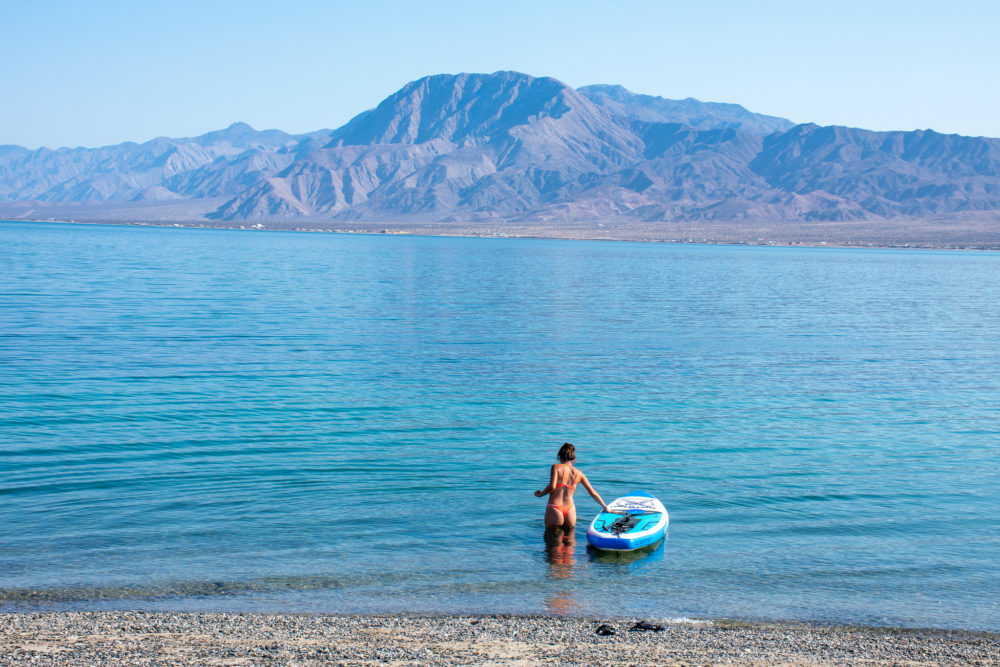
4-Wheel Drive. Is it necessary? That entirely depends on how far off-the-beaten-path you want to venture. My biggest regret about our time in Baja was all the seaside towns, waterfalls, and scenic detours we had to skip because we couldn’t risk getting stuck in the sand. Not to mention the beach camping. I highly recommend a vehicle with 4WD.
Handy Spanish Phrases
Most Baja locals don’t speak English.
& you shouldn’t expect them to. Instead, learn a few key phrases that might come in handy and work with that. You don’t need to know full sentences to communicate effectively.
English
Bathroom
Full (Gas Stations)
Thank You
Hello
You’re Welcome
I’m Sorry
Cheers
I need help
I don’t understand
How much?
Check (restaurant)
Spanish
el Baño
Lleno
Gracias
Hola
De nada
Lo siento
Salud
Necesito Ayuda
No entiendo
Cuanta/Cuanto
Comprueba
Pronunciation
el Banyo
Yayno or Jayno
Grasias
Olaa
De nada
Low See ento
Salood
Nessisito Eye udo
No en tea en doe
Quanta
Com Pray Ba
Obviously, that’s not going to get you very far but it will help with basic everyday interactions.
Everything You Need to Know About Driving in the Baja Peninsula of Mexico
Each country has its own nuances of the road. Drivers in the US are uncharacteristically impatient and heavy on the horn but if you road trip through Laos (or many other parts of Asia), you’ll find that drivers use the horn as a signal rather than a sign of aggression. Similar to Mexico.
Here’s what you need to prepare for when learning to drive in Mexico.

Crossing the Border
Let’s start by getting into the country. You have two points of entry for the Baja Peninsula. Tijuana, the busiest US border crossing, or Mexicali.
It doesn’t particularly matter which you choose, but if you plan on traversing the entire peninsula it’s likely you’ll enter through one and exit through the other. In that case, you should 100% enter through Tijuana. Crossing from the U.S. to Mexico in Tijuana is a breeze. In fact, you should be extra certain you have your passports on hand (for departure) because it’s likely they won’t even stop you to check on the way in.
Our van was ‘searched’ for under a few minutes and we drove on through to TJ. Having said that, be sure to ensure there aren’t any drugs or other contraband in the van. Vans can turn into bottomless storage pits after being on the road, you would hate to have that one joint cause a world of hassle for yourself or be turned around before your road trip even began.
Leaving through the Tijuana border is another story entirely. 20 crowded lanes of bumper to bumper traffic with vendors weaving through their captive audience of cars selling churros, window washes, and blankets. Even at 3 AM, the border crossing takes several hours. & if you’re unfortunate enough (like us) to get stuck in the “Sentri” lanes which are only for global entry pass holders, you’ll end up chatting with a border agent while he explains that everyone gets 3 strikes (or lane mishaps) before they are charged a $5,000 fine.
Rules of the Road
It’s not just Mexican driving culture that’s different. The laws are too. Here’s what you need to keep in mind before driving on the Baja Peninsula.
The infamous left turn signal.
In America, our left turn signal is used to let people know we are making a left-hand turn or changing lanes. In Mexico however, your left-hand blinker signifies that you are allowing someone to pass you and you are confirming the coast is clear for them to do so.
This means if you are making a left-hand turn on a two-lane road, slow all the way down, flip on your blinker and ALWAYS check to make sure someone isn’t going to blindside you trying to pass as you turn. These crashes are common and deadly. Likewise, when, (because you will) you get stuck behind a semi-truck going 15 MPH on winding narrow roads, he will use his signal to let you know when it’s safe to pass him.
Most roadways are single lane which makes passing difficult. Since vans don’t tend to be the fastest things on the road, especially in Baja, it’s best to just hug the shoulder and use your left turn signal to indicate people may pass you.
Drinking & Driving
Drinking and driving is illegal in Mexico, but often rarely enforced. The same goes for open containers, which means you’ll sometimes see locals drinking while they drive. Just be vigilant on the roadways and know that weekends will have the most intoxicated drivers.
Bribes
You can be pulled over in Baja for a wide variety of reasons. Not wearing a seatbelt, speeding (can you convert KM/H to MPH?), or simply because of your American license plate. In any situation, bribery is often an option.
How do you bribe a police officer you ask?
Very discreetly offer $20-$40. Keep it in your vehicle and discreetly show them the cash. Often they don’t want their partners back in the car to know they are pocketing the money. If that doesn’t work you’ll have to go to the local police station to pay your infraction.
Military Check Points
Let me start by saying…this is a place you cannot bribe.
But it sounds a lot more ominous and sketchy than it actually is. There are 6 total on the road down to Cabo. Some you roll through without stopping and give a wave, a couple of them have you exit and then search your vehicle. They are usually very nice, asking where you come from, where you’re going, and if it’s for vacation and send you on your way.
They are looking for “drugas” (drugs) so don’t be surprised if they poke around the inside of your van.
Phrases to know: De donde vienes? – Where are you coming from? Adonde vais? – Where are you going? Military officers very rarely speak English and they will definitely ask you these 2 questions at each checkpoint.
Common Road Hazards
My two biggest driving tips for the Baja Peninsula are don’t drive at night & don’t drive tired. If that means you have to break up the long desert stretches into two days, do it.
Roads in Baja can be very touch-and-go and most stretches have day-ruining potholes, unmarked topes (speed bumps), wildlife crossing, including cows and horses. I found driving in the early morning ensured you aren’t driving through peak heat, which can get intense away from the west coast, and will put you at your destination well before dark. Let’s take a look at common road hazards in Baja and how to avoid them.
Pot Holes & General Disrepair
If you stick to the 2 main highways zig-zagging across Baja, road conditions are good enough. There are errant pot-holes and some general crumbling, but it’s paved the entire way so what more could you ask for.
If you venture off those roads, however, you’ll find washboards covered in a few inches of loose sand and treacherous packed dirt roads with incredibly steep grades. This is where 4WD comes in handy. Just be alert and prepared during drive days.
Erratic Drivers
We already touched on the potential for drunk drivers, but drivers in Baja are a little erratic even sober. Speeding is very common and they take corners at unrecommended speeds. Worst of all, they often pass around blind corners or hills. Just something to keep in mind.
Vacas (Cows)
Why did the cow, wild horse, and goat cross the road?
I don’t actually have a punchline but just keep in mind that they do. Even highways. There are no rules in the desert.
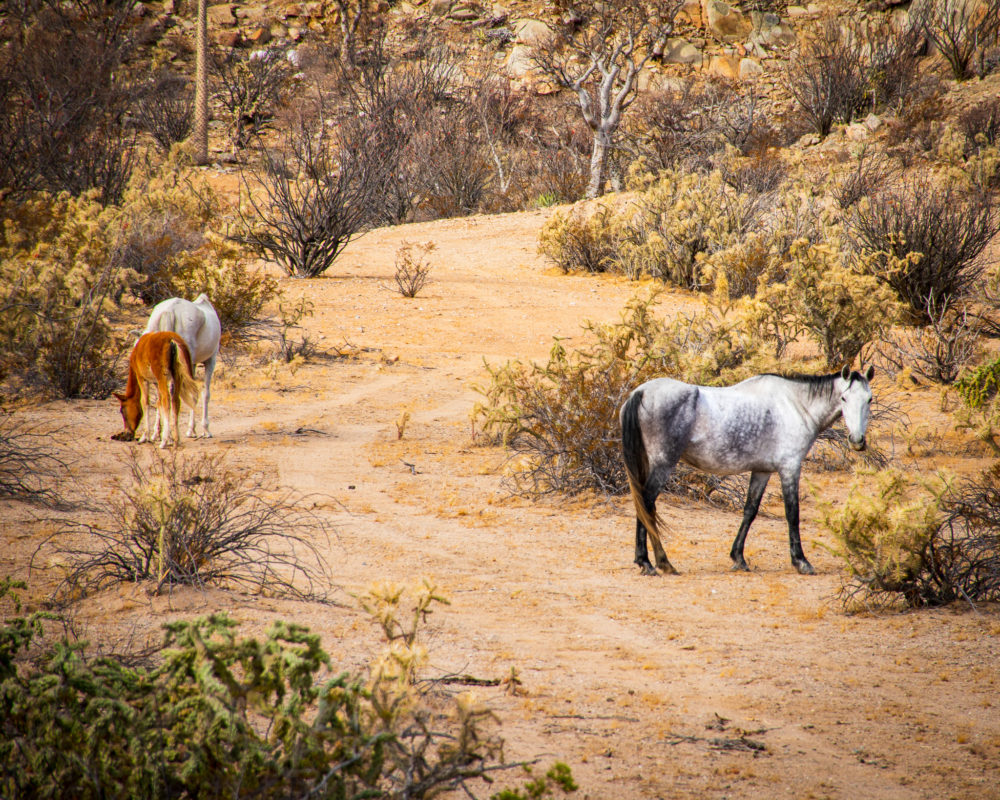
Unmarked Speed Bumps
Topes. Speed bumps. Unpainted and ready to completely destroy your vehicle. These speed bumps are not always marked or have signs near them as any warning. They are usually signaling that you’re coming up on a town, a sharp turn, or a military checkpoint. If you see a sign that says anything about Velocidad (speed), or a town coming up it’s best to slow down. These can sometimes be extremely hard on your suspension (& everything else as you go hurtling over them) so take them as slowly as you possibly can.
Sand
Let’s be honest, the real allure of driving through Baja is the chance to sleep literally on a beach and waking up to the waves crashing and the sun peaking over the water. The reality is often as good as the fantasy, but there is a limit to where you can drive your car before it sinks into pockets of deep and loose sand.
When in doubt, read reviews before you reach your intended beach campsite on iOverlander. If you don’t have service, walk the road a bit and see if the sand feels too loose. A sign of that is the lack of tread or tire tracks on roads. You can also flag down a car coming the other way and see if it’s safe to travel. Also, while I’m throwing out recommendations avoid getting too close to the water. Typically, vans do their best to get as close to the water as possible for the morning coffee views, but that’s also where sand is thickest and most treacherous. I’ve seen many stuck cars getting pulled out by very unamused tow trucks.
If you do get stuck: Have a shovel to dig out your tires. If you don’t have “sand tracks” (specifically for this purpose) you can use your driver and passenger seat floor mats for traction. & then let the air out of your tires. Use this as a last resort or if you know there’s somewhere you can fill them back up. As you press on the gas, twist your steering wheel back and forth to try and shimmy your way out. Ask other beachgoers to help push at the same time. Many are more than willing to help because it’s likely happened to them a time or two. Often you don’t even need to ask. Some of the more developed beaches even have tow services specifically for such scenarios.
Now that I’ve covered all the hazards is a good moment to remind you that a Baja peninsula road trip is no more terrifying or difficult than driving in the United States. I promise. It just takes a little getting used to.
Gassing Up in the Baja Peninsula
It’s almost as easy as gassing up back home.
First things first, gas stations in Mexico aren’t self-service. Like Oregon, they have gas station attendants who handle all the pumping.
Here’s how to handle a typical gas fill-up.
Always be sure to verify that the pump is set to zero. “La bomba esta puesta a cero”. Then they will usually ask if you want premium or Magna. Magna is regular gas. Regular is usually a green pump which sent me into a panic our first fill up thinking I accidentally told him diesel. It is also customary to leave a 20-30 peso tip to attendants who wipe your windows clean while they pump your gas, so always have some coins handy.
Another scam to watch out for is double charging or worse with your credit card. As soon as you can, be sure to check your account statement and make sure you were only charged once. The best way to avoid getting ripped off is to be friendly, smile, and give a “Buenos Dias”, act like it’s not your first rodeo.
Note: some gas stations are CASH ONLY. So always have a stash of cash in case the only gas station for the next 150km doesn’t take credit cards.
Fill up when you can
There are huge stretches of roadway void of any sign of life, or gas for that matter. A good common rule is when you dip just below half a tank, start to assess your gas options. Specifically, the stretch of road between El Rosario de Arriba, Catavina, and Bahia de Los Angeles is a gas desert.
The Green Angels & Roadside Repairs
You just walloped a cow, popped a tire, or slowly petered out of gas. Now what?
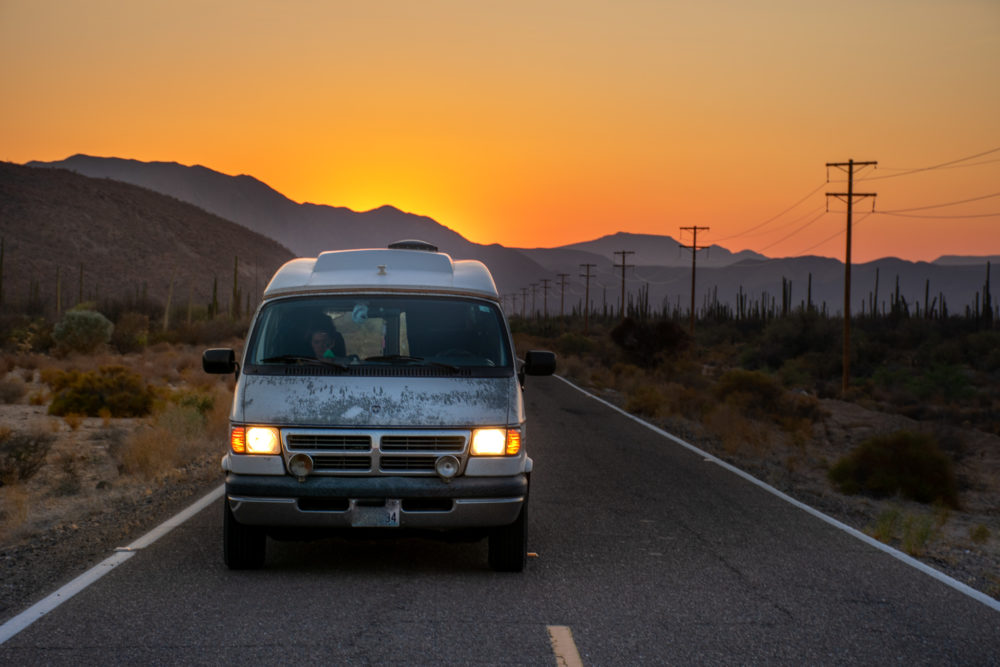
Fortunately, Mexico has a free roadside assistance service called the Green Angels. They patrol the major highways during daytime hours looking for stranded foreigners (& locals). If you happen to have cell service their 24-hour phone number is 01-800-987-8224.
Although the service is technically free it is customary to throw those lifesavers a little tip.
Alternatively, if you need van repairs while in Baja you’re in luck. Mechanic shops and tire repair stores are literally on every corner. It’s common for them to overcharge foreigners…. but what are you gonna do about it?
Tips for Vanlife in Baja
Let’s just pause for a moment & discuss Baja Mexico Vanlife. If you’re planning a road trip with hotels/have no interest in the day-to-day van-dwelling you can just skip this section.
Best Wild Camping in Baja
For the most part, van camping is free in the Baja Peninsula. You can pretty much wild camp anywhere without the risk of being hassled. But finding scenic wild camping is the goal here. Here are 3 tips on finding scenic Baja wild camping to keep in mind.
- IOverlander is great for finding places to sleep. Some of the more developed beaches will charge you to stay for the day or overnight and accept cash (usually 100-200 pesos). They are always very nice and will take trash from you, offer to fill your water, etc.
2. Arrive early. To ensure a good spot on any beach it is wise to get there early. Especially during peak season in the winter, if you don’t get a spot early, they sometimes close the beach to any newcomers.
3. Keep in mind the tides. Try and see where the high tide mark is, and stay above that. As always don’t arrive at dark to avoid getting stuck in sand or unknowingly parking too close to the water.
Read this blog post that details the art of Stealth Camping to become a professional van camper in the US and Mexico.
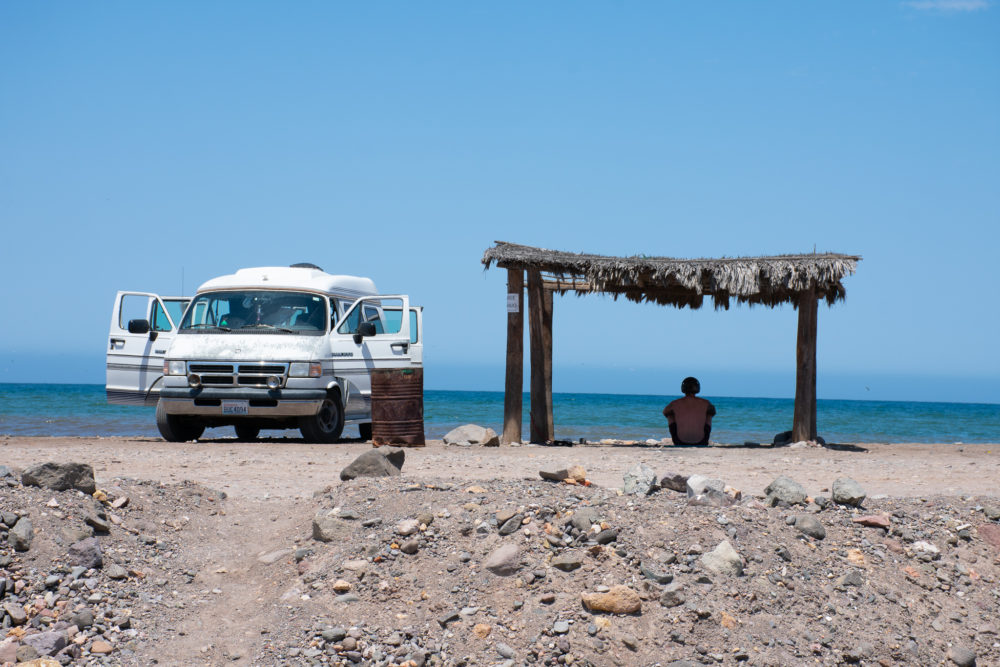
These were my personal favorite wild camp locations in Baja Mexico.
- Playa La Gringa (Bahia de los Angeles)
- San Ignacio town square
- Faro de Mulege (Mulege)
- Playa Santispac
- Playa El Coyote
- Playa El Tecolote
- Playa Balandra
- San Pedrito Beach (Todos Santos)
- La Playita (San Jose del Cabo)
Map of Best Wild Camping in Baja Peninsula
Water Fill Ups & Showers in the Desert
The Baja Peninsula as a whole is one of the driest regions of Mexico. The cities scattered across the peninsula suffer a nearly year-round drought. Water is a scarce resource. But aside from gallon jugs scored at the OXXO convenience stores you’ll also find tons of water refill sites ready to fill any container with freshly filtered water. Just look for blue painted buildings called Water World or anything with “Purificador” in the name.
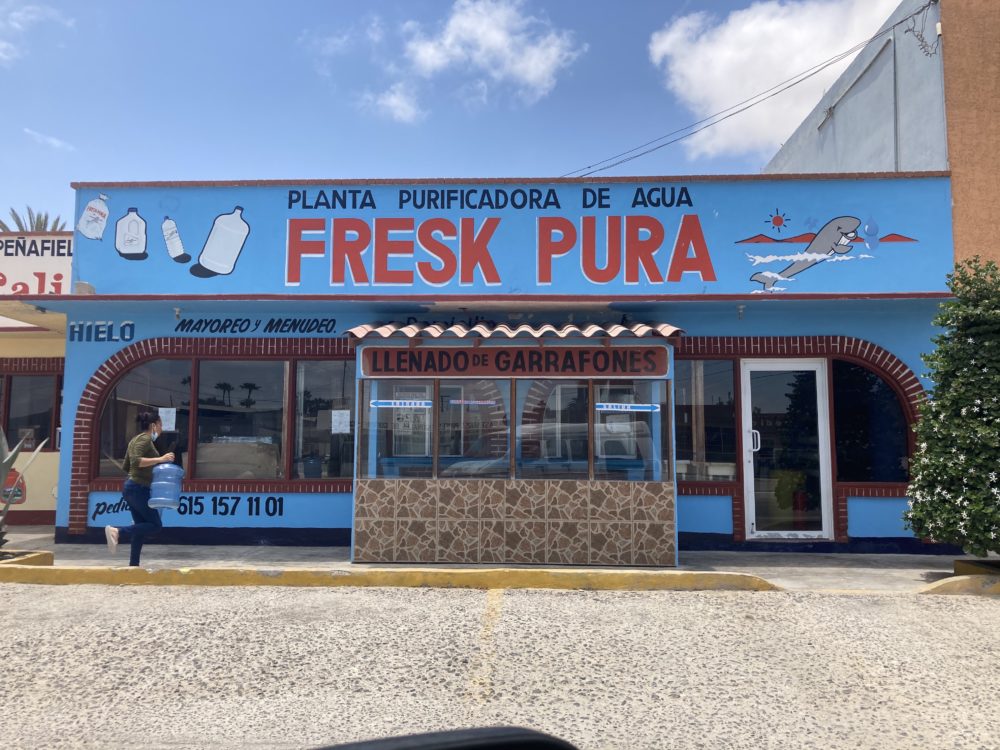
As for showers, if you didn’t grab a shower bag for wild showers you can always pay for one at hostels, large gas stations, or some popular beaches. I resorted to ocean rinses on most days since you’ll be spending so much time covered in saltwater anyways.
The Perfect Baja Road Trip Itinerary
Now you’re ready to hit the road. Click the link below to head to my blog post detailing the perfect Baja Peninsula road trip itinerary.
Invest in a Comprehensive Van Build Guide
Building a van is overwhelming. It often involves countless hours scouring Youtube, blog posts, and facebook groups looking for semi-helpful information. It’s a huge project and when we first purchased our van we didn’t even know where to begin. What van layout should we choose? How do I build everything from scratch (from window covers to shelving)? Should I choose sheep wool insulation or polyiso boards? & these are just the easy questions. Katie & Ben from Two Wandering Soles provide the answers. They created these super neat van build breakdowns to help guide us through the process.
& if you’re a first-time builder I highly recommend their complete van conversion academy.

Investing in Van Conversion Academy Includes…
- Clear blueprints for all the most complicated van systems (I’m talking about you electrical) complete with online shopping lists where you can purchase the exact parts you need.
- Tons of layout options to choose from. They even provide exact blueprints and measurements that you can copy for multiple van designs!
- Access to an exclusive Facebook group of fellow builders where you can ask all the questions your heart desires.
- A COMPLETE step-by-step walk-through on how to build your van from fan installation to sub-flooring to sound dampening to water and propane. They’ve thought of everything including what the most common pitfalls are with each step and how to avoid them.
- Lifelong access to ALL this content. & loads more I won’t cover here.
If you invest in ONE thing before you begin your vanbuild, make it this master course. Katie and Ben helped us build our dream van and whether or not you spring for a Sprinter (we didn’t) or something more budget-friendly they will make sure you get the results you want before hitting the road.
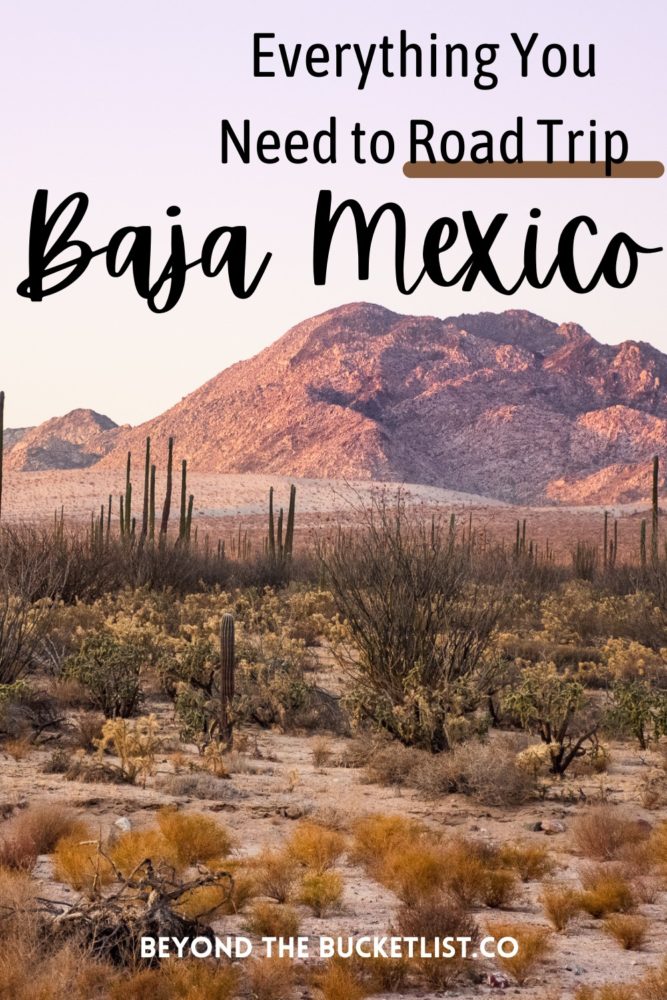

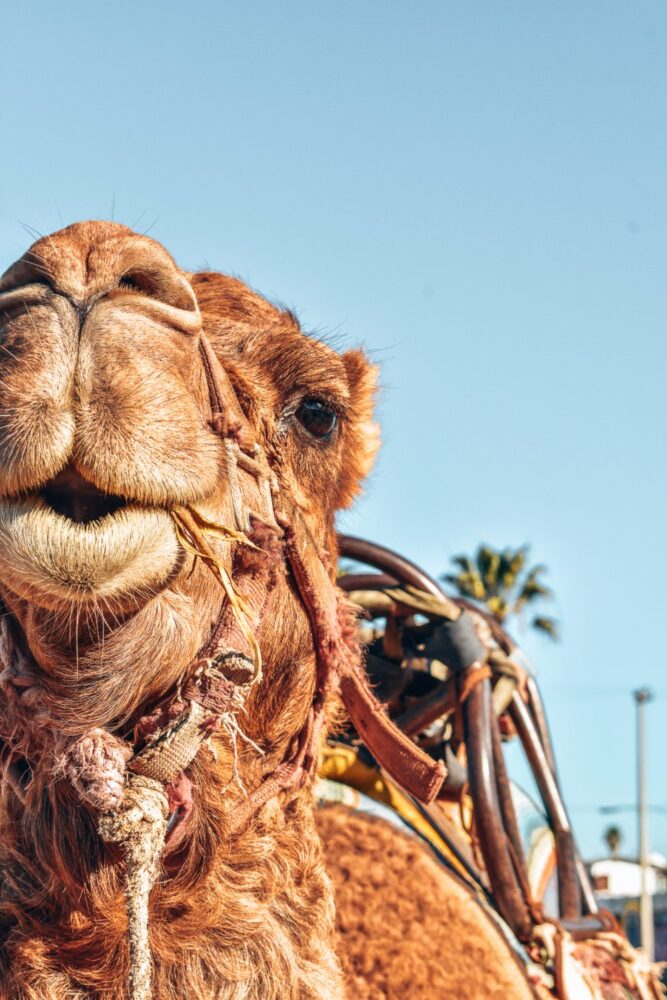
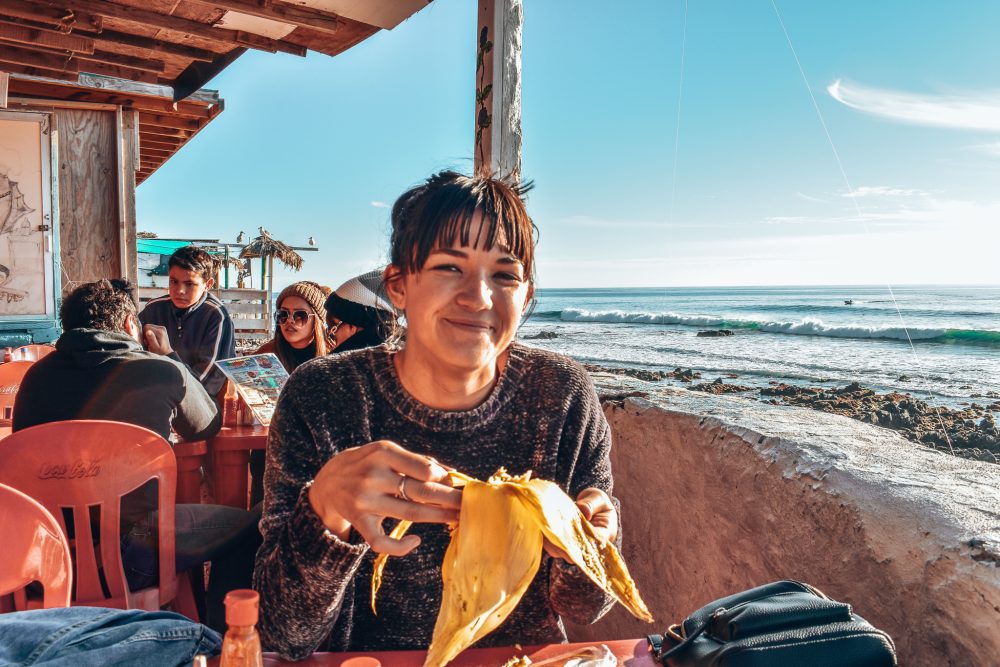
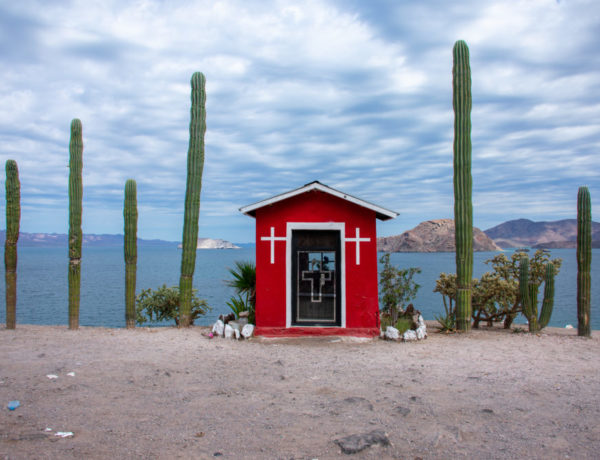


2 Comments
Emily
February 25, 2022 at 10:21 amThis guide is exactly what I was looking for! Thanks for the detailed info, makes me feel prepared for potentially crossing the border!
Josiah
December 10, 2022 at 9:40 pmThis was fantastic. If you come back to baja go to the Escapar van meetup: https://escaparalabaja.com/